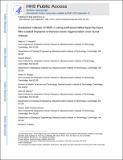Sustained release of BMP-2 using self-assembled layer-by-layer film-coated implants enhances bone regeneration over burst release
Author(s)
Howard, MayLin T; Wang, Sheryl; Berger, Adam G; Martin, John R; Jalili-Firoozinezhad, Sasan; Padera, Robert F; Hammond, Paula T; ... Show more Show less
DownloadAccepted version (2.144Mb)
Open Access Policy
Open Access Policy
Creative Commons Attribution-Noncommercial-Share Alike
Terms of use
Metadata
Show full item recordAbstract
Current clinical products delivering the osteogenic growth factor bone morphogenetic protein 2 (BMP-2) for bone regeneration have been plagued by safety concerns due to a high incidence of off-target effects resulting from bolus release and supraphysiological doses. Layer-by-layer (LbL) film deposition offers the opportunity to coat bone defect-relevant substrates with thin films containing proteins and other therapeutics; however, control of release kinetics is often hampered by interlayer diffusion of drugs throughout the film during assembly, which causes burst drug release. In this work, we present the design of different laponite clay diffusional barrier layer architectures in self-assembled LbL films to modulate the release kinetics of BMP-2 from the surface of a biodegradable implant. Release kinetics were tuned by incorporating laponite in different film arrangements and with varying deposition techniques to achieve release of BMP-2 over 2 days, 4 days, 14 days, and 30 days. Delivery of a low dose (0.5 μg) of BMP-2 over 2 days and 30 days using these LbL film architectures was then compared in an in vivo rat critical size calvarial defect model to determine the effect of BMP-2 release kinetics on bone regeneration. After 6 weeks, sustained release of BMP-2 over 30 days induced 3.7 times higher bone volume and 7.4 times higher bone mineral density as compared with 2-day release of BMP-2, which did not induce more bone growth than the uncoated scaffold control. These findings represent a crucial step in the understanding of how BMP-2 release kinetics influence treatment efficacy and underscore the necessity to optimize protein delivery methods in clinical formulations for bone regeneration. This work could be applied to the delivery of other therapeutic proteins for which careful tuning of the release rate is a key optimization parameter.
Date issued
2022-09Department
Koch Institute for Integrative Cancer Research at MIT; Massachusetts Institute of Technology. Department of Chemical Engineering; Massachusetts Institute of Technology. Department of Biological Engineering; Harvard University--MIT Division of Health Sciences and TechnologyJournal
Biomaterials
Publisher
Elsevier BV
Citation
Howard, MayLin T, Wang, Sheryl, Berger, Adam G, Martin, John R, Jalili-Firoozinezhad, Sasan et al. 2022. "Sustained release of BMP-2 using self-assembled layer-by-layer film-coated implants enhances bone regeneration over burst release." Biomaterials, 288.
Version: Author's final manuscript